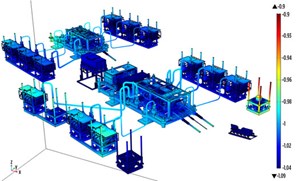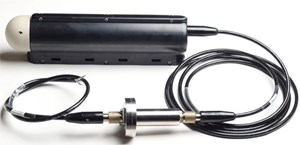FiGS changing the course of the industry once again
Since FiGS® was introduced to the market in 2012, the technology has set an industry standard for subsea cathodic protection (CP) surveys. Traditional inspection techniques, which have used since the 1970s, are painstakingly slow and only provide a partial status of the CP system. Consequently, inspections have been conducted normally at three-year intervals, depending on the operators’ inspection strategy, to monitor the protection level. Remaining life often has had to be based on visual inspection of the anodes.
As with most new technologies, the industry was sceptical in the beginning. “When you have been using the same equipment and techniques for the past 50 years, it can be challenging to accept that there are better ways to do it,” says Leiv Erling Grytten, sales manager at FORCE Technology Norway, Fig. 1. “FiGS® is a non-contact inspection method. We have spent a lot of time convincing the industry that we are able to obtain the same, and in fact much better, results, several meters from the inspection object. We have gone through numerous trials and undergone many technical qualifications to convince our clients and the industry that this is the future.”
HOW DOES IT WORK?
The FiGS® CP survey is a non-contact method that provides both the protection level and life expectancy of the asset cathodic protection system in one pass. The unique sensitivity of the sensor allows ROV’s or AUV’s to pass structures from a safe distance. Unlike traditional table reporting of the CP readings, a FiGS® delivery includes a calibrated CP model, providing a visual representation of the protection level and how it will evolve over time. Figure 2 shows a plot of the protection level for a drill center.

The latest in pipeline surveys is to run fast ROVs or AUVs at 4 to 5 m above the pipeline, collecting visual data from high-definition still cameras that shoot pictures at high frequencies. This provides high-definition photogrammetry of the pipeline instead of infinite hours of video. The height and speed during these surveys do not allow for traditional video cameras and cannot be combined with traditional CP inspection equipment. Because the FiGS® sensor allows the ROVs or AUVs to pass the structures from a safe distance, it allows faster inspection speeds. Going five to 10 times faster than one would with traditional methods saves valuable vessel time and money, and reduced the carbon footprint.
INDUSTRY CHALLENGES AND A RISING PANDEMIC
Up until recently, both traditional and FiGS® CP surveys have also meant sending personnel offshore, which normally means adding a two-man team onboard the survey vessel. The industry aims to keep personnel onboard to a minimum, from a cost, HSE and limited POB perspective. Offshore campaigns are often complex, with several tasks to complete in a short time. Having a dedicated team for CP surveys often results in a lot of waiting time onboard for other tasks to be completed between the CP-related tasks.
“Sending personnel to other corners of the world is not only a lot of work logistically, it also requires a big pool of inspectors ready to go at a short notice,” explained Grytten. “On top of that, vessel schedules tend to change rapidly. Keeping personnel at hotels around the world on standby, waiting for the vessel to mobilize, adds unnecessary costs and inconvenience. Even under normal non-pandemic conditions, moving people across continents to perform surveys is inefficient, expensive, and not very friendly to the environment. With Covid-19, it became a lot more challenging, sometimes even impossible.”
When Covid-19 hit, FORCE Technology Norway had assignments in all parts of the world. Sending personnel across borders and continents to perform FiGS® surveys suddenly became a lot more challenging. CP surveys performed in Norway continued, more or less unaffected, but over 50 % of the assignments were located internationally. The first few international assignments were handled with exception Visas and quarantine, which obviously drove up the overall cost.
“It was hard to justify the added cost for small assignments,” continued Grytten. “In some projects, the mobilization cost, alone, drove the overall costs up by 30%. You don’t need a business degree to understand that these conditions are less than competitive. We needed to think outside the box.”
FORCE Technology Norway and the FiGS® team decided to take another huge leap, this time to remote operations.
FIGS® REMOTE OPERATIONS
The company had a client on the other side of the world that desperately needed a FiGS® CP survey. “The country was in full lockdown, with nobody coming in or out,” explained Grytten. “Luckily, we had just finished developing our latest FiGS® sensor, FiGS® 2.0, which is designed for unmanned vehicles. The new sensor is designed to stay subsea over longer periods of time and does not require an operator present.” The latest FiGS® sensor is designed particularly for resident ROVs, AUVs and small ROVs. It is hydrodynamically shaped, with a weight of only 2.5 kg wet, Fig. 3.
If FORCE Technology Norway were to undertake the assignment, the only way forward would be to send only the equipment and find a way to operate it remotely.
“When NASA can operate a rover on Mars, we should be able to operate our equipment on the other side of the globe,” noted Grytten.
The assignment was the start of a fast-track development project for the FiGS® team. “We needed to come up with a solid plan for maximizing our chances of success and minimise risks,” said Grytten. “To my knowledge, we would be the first company to conduct a CP survey remotely. The fact that the survey was going to be conducted on the other side of the world, as far away from us here in Norway as possible, made it extra fun and special.”
Up until this point, FORCE Technology Norway had only used its own trained and certified inspectors for FiGS® CP surveys, and there was always an inspector on the vessel for mobilizing the equipment to the ROV, logging the data, as well as guiding the ROV pilots during survey. They needed to remotely train a local technician to mobilize and set up the equipment on the ROV.
FORCE Academy, a branch of FORCE Technology that educates and certifies NDT personnel, had recently started its “blended learning” program. The firm’s traditional NDT courses, where students get all their training at facilities in Norway and Denmark, now combines e-learning with practical training-house. Their expertise came in handy, when a digital training course was prepared, producing course material and training videos for external personnel.
“We needed a training program for external personnel to interface and handle the equipment, providing enough information to set everything up on site,” explained Grytten. “All correspondence and data logging during the survey would be handled by us remotely. It was not necessary for them to be experts in Cathodic Protection.”
A remote operations room had to be set up at the office in Trondheim, Norway, to remotely operate the FiGS® equipment onboard the vessel. The room needed a secure and redundant internet connection to be able to operate the equipment, as well as a live video-link and communications with the ROV crew.
The survey was conducted successfully over four days of remote operation from Norway in December 2020. The client was extremely satisfied with the survey. Everything from the use of external personnel for interfacing and hooking up the equipment, to the remote connection during operation, exceeded all parties’ expectations. It was the first of many remote operations to come. FORCE Technology Norway has already received several contracts for remote operations in 2021, and remote operations have become a standard option on all projects. Once again, FiGS® is changing the course of the industry.
“I am very proud of the team for getting everything in place in such a short time,” said Grytten. “It only took about three months from when we received the order to conducting our first remote operation. We are yet again paving a new path for the industry. Remote operations are the future for sure. In the short run, it means that we can continue to operate, unaffected by the current Covid-19 situation, but more importantly, we are showing the industry our unique position with cutting-edge technology that reduces costs, POB and limits the carbon footprint. We can now log on to any location in the world and offer our unique services from the comfort and safety of our own offices.”
- Advancing offshore decarbonization through electrification of FPSOs (March 2024)
- Digital transformation/Late-life optimization: Harnessing data-driven strategies for late-life optimization (March 2024)
- The reserves replacement dilemma: Can intelligent digital technologies fill the supply gap? (March 2024)
- Digital tool kit enhances real-time decision-making to improve drilling efficiency and performance (February 2024)
- Digital transformation: Digital twins help to make the invisible, visible in Indonesia’s energy industry (January 2024)
- Digital transformation: A breakthrough year for digitalization in the offshore sector (January 2024)




